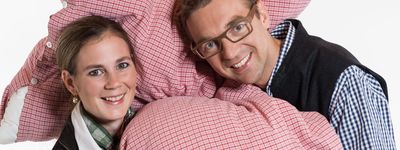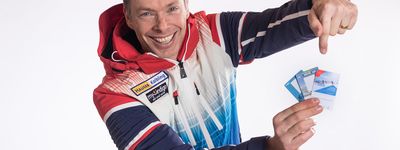our history
More than 100 years of alpine skiing on Hauser Kaibling
It all started in 1907, with the fateful encounter of then-mayor Johann Stiegler and the 18-year-old Viennese student Hans Hofmann. The young man who loved hiking in the mountains, suggested the mayor build a shelter on Hauser Kaibling. And that very same day, excited by the idea, Mayor Johann Stiegler took Hofmann’s spoke to the village’s most important men. Mere weeks later, plans for the shelter were underway.
The young student sketched his idea of the shelter hut and everyone agreed it should go on a rather flat part at the top of the hill called Crystal. Hofmann contacted the press – including the regional Ennstaler – and shared their undertaking with the public.
On reading about the hut, ski enthusiast Friedrich Kabusch and master carpenter Emanuel Kotrasch, who had already crafted a number of skis, joined the Shelter on Hauser Kaibling project.
After a successful fundraising campaign to finance the project, building work started in spring 1908. Entirely made of wood and with simple equipment, the hut soon hosted its first guests. With the consent of the imperial family, it was named Kaiser-Franz-Joseph-Jubiläums-Schutzhaus.
Tragically, on 30th May 1921, the first Krummholz hut completely burned down. But the owners rebuilt it, even larger and more beautiful than before. And the guests kept coming to the hut. To have something to offer, the project officials hosted an annual Krummholz get-together in Haus im Ennstal, organising ski and toboggan races. The first Krummholz race took place on 1st February 1914. Back then, however, there were no groomed ski runs, and the only flattened parts of a racecourse were the start and the finish.
The Great War (1914–1918) interrupted efforts of the people of Haus. Then the Great Depression hit. It was not until January 1927 that the Alpine Association could host an eight-day ski course at the Krummholz Hut. However, only a few years later, the Second World War broke out and the situation got worse again.
Only when the Second World War started to become a memory did Thomas Scharfetter think about setting up a cable car for sending supplies and materials to the hut. It opened in 1947, and two years later, the cable car became Schladming Dachstein’s first gondola.
It was a relatively small metal lift for only four people, but it was a sensation in the Enns valley. Thanks to the new gondola, the IV Winter Games came to the region in 1951. Dubbed the Small Olympics, the event hosted downhill, slalom and giant slalom skiing as well as cross-country skiing, ski jumping and ice-skating as well as the championships for people with disabilities.
In 1957, Gustav and Ottilie Höflehner decided to rebuild their hill farm on Hauser Kaibling’s east slope, integrating ten guest rooms. To boost winter tourism, Gustav Höflehner set up the first ski lift next to the guest house in 1958. … and the next stage in Hauser Kaibling’s life started.
Come 1959, Thomas Scharfetter planned a new gondola, hoping to hit a capacity of 100 people per hour. After several long discussions, the local council decided to fund it with an ERP (tourist promotion) loan. In 1960, he newly built his gondola equipped with four cabins.
This exciting new facility meant Hauser Kaibling was selected to host the Austrian Alpine Ski Championships 1963, putting Haus im Ennstal at the top of alpine skiing. Mr. Scharfetter had always been a man for the essential, and his son-in-law, Maximilian Sampl, a painter, perfectly suited their endeavours. He insisted every building looked pristine and his wife, Gertrude, applied her considerable skills in economics to keeping the books and accounts in perfect order.
Also at the beginning of the Sixties, Alois Moser saw huge ski potential on the scenic Kaiblingalm and built the first Alm ski lift. To help skiers back to the Krummholz hut, they set up a simple drag service. Alois Moser’s Alm lift ran from 1961 to 1965, when it was replaced by a new, longer drag lift. The Moser ski lift stayed in the family until the local ski lift company, the Hauser Kaibling Seilbahn- und Liftges.m.b.H. & Co KG, bought it in 1991.
While Moser was building his ski area, Karl Gerhadter built a drag lift on his slope, the Haberlleiten. Further pioneers of the first generation were Franz Kitzer, Franz Kulmhofer and Karl Moosbrugger. Kitzer operated his pendular lift at three places between 1957 and 1966.
In the Sixties and Seventies, tourism boomed, and the Tauern gondola hit its limits. Thanks to constant bookings, in 1966, the Höflehner family built a guesthouse with room for 35 guests. In 1967, the Sampl family added the summit lift. In that same year, Alm ski lift II was added, opening up ski runs in the Kaiblingalm.
In 1971, three more drag lifts followed, starting at the middle station. The Höflehner family built more two drag lifts in the Seventies. And as well as the busy Tauern gondola, minibuses transported people up the mountain – but the waiting time was still a couple of hours.
In 1972/1973, a monocable lift came to Planai. After the first men’s World Cup race on Planai in 1973, the call for the Alpine World Ski Championships got louder and louder. And finally, on 19th May 1979,Haus im Ennstal and Schladming were elected to host the Alpine World Ski Championships 1982. The locals were ecstatic.
Plans for a new gondola became top priority, but during the planning stages, it was clear that a gondola up to the Krummholz hut wasn’t fundable. They had to get used to the idea of a feeder lift to the middle station. Everyone agreed to the location for the base station in the valley, the Ennsling Gmalbachl, close to the main road.
Soon the Haus races were scheduled: four ladies’ events and the men’s combined event. To make it work, landowners needed to work together and agree access rights – which wasn’t always easy – but in the end, a sense of community prevailed.
In March 1980, the new Hauser Kaibling Seilbahn- und Liftges.m.b.H. & Co KG association was founded. It acquired the Hartweger lift and construction work on the new four-seater gondola started the following summer – and the 2519 m gondola was ready to go in less than six months.
From December 1981, the offices of the Organizing Committee Haus (OC House) were fully occupied. During the most intensive time, more than 2000 volunteers supported the OC. Looking back, it is clear that the success of the event was down to the army of volunteers; it was the first time Haus im Ennstal and Schladming proved they are more than capable of hosting such huge events.
In 1983, Haus im Ennstal successfully hosted its first independent ladies’ World cup race, with the competition returning again in 2001, 2004 and 2010.
For the Höflehner family, building a new guesthouse was essential to meet demand. To support the building works, Helmut Höflehner – by then a successful ski racer – became a partner in his parent’s guesthouse. In December 1987, after a record building time of only seven months, they opened the all-new and exciting Knapplhof. But the snow failed to appear.
Instead of investing in a few chairlifts, Gustav Höflehner put his money into a snow-making system. It turned out to be the right decision and became the first artificial snow-making facility in the ski area. Tragically, Gustav Höflehner didn’t get to enjoy the success of his new technology. The day it started running, he was admitted to hospital and never came home.
After Gustav Höflehner’s death, his eldest son Reinhard took over the hotel. Helmut Höflehner, too, decided to continue his father’s work, taking over the ski lifts.
The two Sampl sons also stepped into their family business. As partners of the Sampl KG, in 1990, Dr. Maximilian Sampl Jr. pushed for the formation of the Hauser Kaibling Betriebsges.m.b.H. & Co KG. An association owned half by Sampl KG and half by Hauser Kaibling Seilbahn and Liftges.m.b.H & Co KG. To finally connect these two local companies, all Sampl family ski lifts joined the Hauser Kaibling Betriebsges.m.b.H. & Co KG, except for the pioneering work of grandfather Sampl: the Schladming Tauern Gondola lift, which, still today, is part of the Sampl family.
In 1992, the new association set up the four-seater Quattralpina chairlift, which leads from Hauser Kaibling’s eight-seater gondola top station to the tower plateau. In 1996, Helmut Höflehner replaced the aging Gumpen ski lift with a detachable four-seater chairlift with weather bubbles, called the Höfi- Express I
In 1998, the four ski mountains finally made the decision happened to interconnect, becoming Hauser Kaibling-Planai-Hochwurzen-Reiteralm. A ski carousel. To achieve this, they needed a new ski run from Kaiblingalm down to Gföhl and a ski lift back up to the tower plateau. A detachable chairlift, the Senderbahn, built in 1998, did the job. The connection of the four ski areas was completed to great celebration in 1999.
In the year 2000, the old four-seater gondola from the valley to the middle station was replaced by a modern eight-seater gondola with all new top and base station. Also in 2000, a new sports shop and a building for the local ski school were added. One year later, the neighbouring building was upgraded, making it the WM-Arena. In 2001, a four-seater chairlift, the Höfi-Express II, replaced the last draglift.
It was also time to upgrade the now outdated snow-making facilities. Year after year, the slopes needed more artificial snow, so the partners created a precisely organised masterplan. They decided to go for a low-pressure facility with high-quality propeller snow makers made by the South Tyrolean company TechnoAlpin. In 2006, the Ennslingalm storage reservoir and pump station was built at 1,720 metres. And ever since 2006, the snow-making facilities have been upgraded and optimized.
As well as making huge investments, the partners also widened the ski runs, upgraded the ski-run guidance system and created a large car park at the base station.
In 2009, they replaced the summit ski lift with a four-seater detachable chairlift. And, that same year, turned the Knapplhof at the bottom of the Höfi-Express I into the Nature and Wellness Hotel with 30 new rooms, a spa with indoor and outdoor pool and much more. In 2010, the new service centre at the top of the eight-seater gondola opening, perfectly complementing the infrastructure of the valley.
At the 2008 FIS Congress in Cape Town, Schladming was elected to host the Alpine World Ski Championships 2013. To celebrate, Kaiblingalm welcomed the giant Alm 6er chairlift project thanks to an injection of infrastructure funding. The additional finance meant they could also finish the new reservoir lake in Kaiblingalm.
During the Kablingalm upgrades, managing director Arthur Moser wanted to put looking after the environment high on the agenda. He wanted to step as lightly as possible on the mountain’s nature. Looking back, this upgrade was one of the most extensive since the arrival of Hauser Kaibling’s ski lifts.
During preparation works for the FIS Alpine World Ski Championships 2013, Haus managed to take a big step forward. For several years, the German National Ski Team had trained on Hauser Kaibling. In the run-up to the Worlds 2013, they worked on deepening the amicable relationship with the German Ski Association DSV.
The ski-lift company, the village council and the Haus im Ennstal tourist office decided to work on becoming Germany’s official homeground for the Ski World Championships 2013. After constructive talks with the DSV, they settled on a quaint hut in the center of the village, at the Schlossplatz. With 500 m2, it had space for more than 200 people. Locals, athletes, coaches, as well as personalities from industry, politic and sports would spend many happy hours in the Germany House.
Thanks to the charming rustic hut, Haus im Ennstal village and the Hauser Kaibling brand flew into the spotlight during the FIS Alpine World Ski Championships 2013.
That same year, Hauser Kaibling was named European Ski Area Test Winner 2013. During the summer of 2013, Hauser Kaibling created a large modern ski depot at the base station and upgraded the Sport Hauser Kaibling sports shop.
Come autumn 2014, Hauser Kaibling sealed a PR agreement with Thomas Sykora. From then on, the slalom World Cup winner and ORF co-host wears the Hauser Kaibling branding on his shirt, acting as brand ambassador and taking Hauser Kaibling to the world.
In the 2016, Kaiblingalm added a 700-metre funslope, which quickly became very popular – so much so that it was upgraded to 1,460 metres in 2018.
The AlmArenA is a unique combination of aprés ski, bar and restaurant. Opened in 2017, it wasted no time in becoming an established gastronomic highlight in Schladming Dachstein. Also, the base station went barrier-free and added a bus-driver lounge, info point and new toilet facilities. The one-time Gondelstüberl also got a facelift, reopening as Stoni’s Rauchkuchl.
Summer 2019 saw another milestone set. For the first time, the eight-seater gondola and four-seater chairlift Quattralpina operated in summer, shuttling visitors to the children’s adventure path, petting zoo, e-trial bikes, disc golf course, children’s playgrounds, and much more. The bike and hike trails also got upgraded.
Probably time to enjoy a visit to Hauser Kaibling in Schladming Dachstein!
Imprint book:
Creators of the book
Martin Hutegger and Karin Essl-Colonne (Agentur Lemon), Heinz L. Dietmayer, Bettina Gruber, Martin Huber, Joachim Lindner, Carina Röder und Mag. (FH) Stefanie Ott.
Cover:
Marlene Schaumberger, 8973 Pichl/Enns, www.arthof.net
Photographers:
Clemens Handl, Gerhard Wolkersdorfer, Gernot Langs, Martin Baumgartner Photography, Martin Huber, Archiv "Der Ennstaler", Wildbild/Günter Freund,Gregor Hartl Fotografie, Harald Steiner/Foto Moom, Photo Austria HP Steiner, Viewcopter Rudi Schneeberger, Herbert Raffalt, Elke Reinbacher, Familie Sampl, Familie Höflehner, Daniel Scharinger, Franz Kulmhofer, Alois Moser, Sepp Brandner, Herbert Stocker, Manfred Doppelhofer, Bernd Gerhardter, Doris Resch, Erwin Fuchs, Werner Lehner, Hans Süß, Harry Trauderer, Joel Kernasenko, Karin Schneider, Fritz Baumann, Manü Cherlias, Familie Frühwirt, Familie Eggmayr, Familie Wageneder, Alfred Trinker, Reinhard Promok, Karl Moosbrugger, Engelbert Wieser, Hans Simonlehner, Matthias Pilz, Johann Stocker, Karl Wachlinger, Archive Hauser Kaibling, Archive Gemeinde Haus, Archive Snowsports Museum Haus, Archive ÖAV-Haus, Archive Tourist Office Haus-Aich-Gössenberg, Archive Union Haus, GEPA pictures, Archive Ski amadé, Archive Schladming Dachstein Tourism Marketing GmbH, Archive Styrian Sheep and Goat Breeding Association, Chamber of Commerce Styria, PistenBully.




